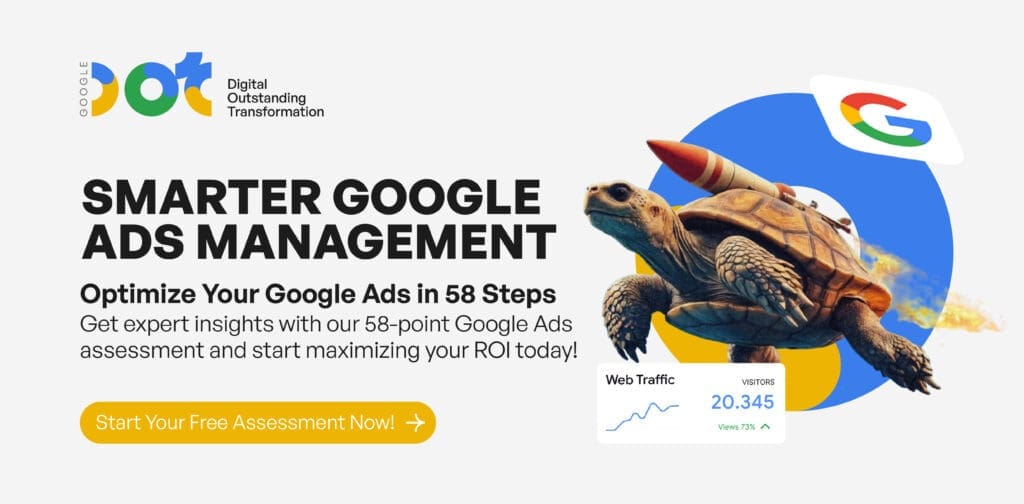Ever feel like you’re burning cash on Google advertising with nothing to show for it? You’re not alone. Many businesses pour money into campaigns without a clear strategy—resulting in wasted budgets and underwhelming results. But here’s the thing: Google Ads isn’t just for big brands with deep pockets. When done right, it’s one of the fastest ways to get in front of customers who are actively searching for what you offer.
This guide breaks down everything you need to know about advertising on Google—without the jargon or guesswork. Here’s what we’ll cover:
- How Google Ads actually works—from bidding to Quality Score and ad relevance.
- Step-by-step campaign setup—choosing the right keywords, ad types, and budgets.
- Optimization and scaling—avoiding common pitfalls, improving performance, and maximizing ROI.
P.S., if you’re looking for hands-on help with Google Advertising, The DOT Google has certified experts who build high-performing campaigns that don’t just drive clicks—but real results.

How Google Advertising Actually Works
Google Ads isn’t just about bidding the highest—it’s about relevance, strategy, and optimization. If you’ve ever wondered why some ads show up at the top while others are buried on page two, here’s the answer:
1. The Google Advertising Auction System
Every time someone searches for something on Google, an ad auction takes place. Google looks at:
- Your bid – How much you’re willing to pay per click.
- Ad Relevance & Quality Score – Are your keywords, landing page, and ad copy aligned?
- Expected impact – Does your ad get high engagement (clicks, conversions, etc.)?
Google then assigns an Ad Rank, which determines whether your ad appears—and where. Spoiler: You don’t always need the highest bid to win. A well-optimized, highly relevant ad can outrank competitors even if their budget is bigger.
2. Keyword Match Types
Not all keywords work the same way in Google Ads. If you’re targeting the wrong ones, you might be throwing money at irrelevant searches. Here’s how match types work:
| Match Type | Example Keyword: “best coffee shop” | When Your Ad Appears |
| Broad Match | Best coffee shop | Related searches like “coffee near me” or “cafés” |
| Phrase Match | “Best coffee shop” | Searches including that phrase, like “best coffee shop in NYC” |
| Exact Match | [Best coffee shop] | Only for that exact term or close variations |
Pro Tip: Use Phrase Match for targeted traffic with some flexibility. Broad Match can waste budget, while Exact Match can be too restrictive.
Setting Up a High-Performing Google Advertising Campaign
A successful Google advertising campaign doesn’t start with launching ads—it starts with strategy. Here’s how to set yourself up for success:
1. Define Your Google Advertising Goals
Before spending a dollar on Google advertising, ask yourself: What do I want from this campaign? Google Ads can drive:
- Website traffic – More visitors, more awareness.
- Leads & sales – Phone calls, sign-ups, purchases.
- Local visits – More foot traffic for physical stores.
Pro Tip: If you’re still not sure how to start, consider talking to a Google ad agency to help you kickstart your campaign. Just make sure that you choose a certified Google partner to get the job done.
2. Choose the Right Campaign Type
Google offers several campaign types, each serving different purposes.
| Campaign Type | Best For |
| Search Ads | High-intent users actively searching for your product/service. |
| Display Ads | Building brand awareness with image/banner ads on websites. |
| Shopping Ads | E-commerce businesses showcasing product images/prices. |
| Video Ads (YouTube) | Engaging potential customers through video content. |
| Performance Max | AI-driven, cross-channel advertising for maximum reach. |
Pro Tip: Search Ads are the best place to start for most businesses—they capture demand from people who are actively looking for what you offer.
3. Find the Right Keywords
The right keywords = the right audience. Use Google’s Keyword Planner to:
- Identify high-intent search terms.
- Check search volume and competition.
- Find low-cost opportunities with high ROI.
Look for commercial intent keywords—terms that indicate someone is ready to take action.
- Bad Keyword: “How to make coffee” (too broad, no purchase intent)
- Good Keyword: “Buy espresso machine online” (high intent, ready to buy)
4. Write Click-Worthy Ads
Your ad copy needs to stop the scroll and get clicks. Here’s a formula that works:
- Headline: Solve a problem or highlight a benefit (“Get Affordable SEO in 24 Hours”)
- Description: What makes you different? (“Certified experts. No long-term contracts. Results-driven strategy.”)
- Call to Action (CTA): Tell them what to do next (“Start Your Free Audit”)
5. Set a Google Advertising Budget & Bidding Strategy
Not sure how much to spend on Google advertising? Start small, test, then scale.
- Daily budget: The amount you’re comfortable spending per day.
- Bidding strategy:
- Maximize Clicks – Great for traffic.
- Maximize Conversions – Google auto-adjusts bids for more sales.
- Target ROAS (Return on Ad Spend) – AI-driven, ideal for scaling.
6. Optimize Landing Pages for Conversions
Your ad is only half the equation. If your landing page isn’t optimized, you’ll lose customers before they convert. Here’s what to check:
- Fast load speed – Aim for under 3 seconds.
- Clear CTA – Make it obvious what action to take.
- Mobile-friendly design – Most users browse on their phones.
- No distractions – Remove unnecessary links or pop-ups.
The DOT Google helps businesses fine-tune landing pages so clicks turn into customers. Whether it’s faster load times or clearer messaging, small tweaks can mean big results.
Ongoing Optimization: How to Improve Performance Over Time
Now that your campaign is up and running, it’s time to optimize, scale, and maximize your ROI. Running Google Ads isn’t just about setting it and forgetting it—it’s about continuous improvement.
Even the best campaigns need fine-tuning. These are the key areas to monitor and adjust:
1. Track the Right Metrics
Without data, you’re flying blind. Keep a close eye on:
- Click-Through Rate (CTR): Are people clicking on your ads? Low CTR means your ad copy or targeting needs improvement.
- Quality Score: Google’s 1-10 rating of your keyword relevance, landing page, and CTR. A high score = lower ad costs.
- Conversion Rate: Are visitors taking action (buying, signing up, calling)?
- Cost Per Conversion (CPA): How much you spend per lead or sale. Lowering this boosts profitability.
Pro Tip: Make sure to use every Google service available like Google Analytics & Reporting to gain deeper insights into user behavior and track real results. If you need help setting it up, The DOT Google offers customized dashboards and tracking solutions.
2. Use Negative Keywords to Filter Out Bad Traffic
Spending money on irrelevant searches? You’re not alone. Adding negative keywords prevents your ad from showing up for searches that don’t match your intent.
Example: If you sell premium coffee, adding “cheap” as a negative keyword stops people looking for discount coffee from clicking your ad.
Common negative keywords to consider:
- Free (if you’re selling something)
- Jobs, careers, hiring (if you’re not looking for employees)
- How to, DIY (if you sell services, not tutorials)
Case Study: How Negative Keywords Transformed Lead Quality for a Dubai Business Consultant
If you’re paying for traffic that won’t convert, you’re burning money. That’s exactly what was happening to a Dubai-based B2B consultancy before they partnered with The DOT Google. They were drowning in unqualified leads—87% of their conversions were irrelevant. Job seekers, suppliers, and low-budget businesses kept clicking on their ads, but none of them were actually looking for their services.
They needed a fix—fast.
The Problem: Wasted Budget on the Wrong Audience
The consultancy specializes in high-value business services like feasibility studies, business planning, and board advisory. But their Google Ads budget was being drained by people who had no intent to buy.
Here’s where things went wrong:
- Their ads appeared for searches like “business consultant jobs” and “cheap business planning services.”
- They weren’t using enough negative keywords to filter out bad traffic.
- Their sales team was wasting time on leads that were never going to convert.
They needed qualified leads—business owners who were ready to invest in expert consulting.
The Fix: Data-Driven Negative Keyword Strategy
- Analyzed search term reports to see exactly which keywords were attracting unqualified traffic.
- Built a custom negative keyword list to block irrelevant searches like “free,” “jobs,” “cheap,” and “suppliers.”
- Ran exploratory campaigns to identify high-intent search terms while filtering out wasted clicks.
- Refined targeting and ad copy to better align with their ideal audience.
The Results: From 87% Unqualified to 91% Qualified Leads
- Non-qualified leads dropped from 87% to just 9%.
- The sales pipeline was consistently filled with high-value prospects.
- Google’s AI tool was trained to prioritize qualified traffic, improving long-term campaign performance.
Why This Matters for Your Google Advertising Strategy
If your ads aren’t bringing in the right people, you’re throwing money away. A strong negative keyword strategy helps you:
- Stop irrelevant clicks before they waste your budget.
- Focus on real customers who are actively searching for what you offer.
- Improve ad relevance and Quality Score, lowering costs over time.
Want to filter out wasted ad spending like this consultancy did? The DOT Google helps businesses refine their Google Ads targeting so every dollar works smarter, not harder.
3. A/B Test Everything
Never assume what works—test it. Small tweaks can lead to big gains. A/B test:
- Headlines – Does “Get Affordable SEO” perform better than “SEO That Works”?
- Call to Action (CTA) – “Sign Up Now” vs. “Claim Your Free Trial”
- Landing Pages – Different layouts, images, or copy variations
Scaling: How to Grow Without Wasting Money
Once your campaign is profitable, it’s time to scale. Here’s how to expand while keeping costs in check:
1. Increase Your Google Advertising Budget Gradually
Don’t double your budget overnight. Instead:
- Increase spend by 10-20% at a time and track performance.
- Shift the budget to top-performing keywords while cutting low-performers.
- Use automated bidding strategies like Target ROAS to let Google adjust bids dynamically.
2. Expand to New Audiences
Once you’ve nailed your core audience, test:
- Lookalike Audiences – People similar to your best customers.
- Competitor Keywords – Target searches related to rival brands.
- Retargeting Ads – Show ads to people who visited your site but didn’t convert.
Pro Tip: Google Display & YouTube Ads are great for retargeting. You can remind past visitors about your brand with banner ads or short video clips.
3. Automate & Streamline with Google Advertising Tools
Manual campaign management can get overwhelming. Google’s automation tools can help:
- Smart Bidding: AI-driven bid adjustments for better performance.
- Responsive Search Ads: Google tests different headlines & descriptions for you.
- Performance Max: An all-in-one AI-powered campaign for maximum reach across Google platforms.
The DOT Google specializes in Google Ads Management—so if you’d rather focus on running your business while experts optimize, test, and scale your campaigns, you know where to find us.
Google Advertising Without the Guesswork—Let’s Get It Right
You’ve got the blueprint. No more wasted ad spend. No more confusion over keywords, bidding, or optimization. Now, it’s about taking action and refining your strategy over time. Keep these key takeaways in mind as you build and scale your campaigns:
- Google Ads rewards relevance—a high “Quality Score” can lower costs and boost rankings.
- Testing is everything—A/B test your ads, landing pages, and bidding strategies.
- Smart scaling beats reckless spending—increase budgets gradually and focus on high-performing campaigns.
Running Google Ads doesn’t have to be a solo mission. Whether you’re just starting out or looking to scale, The DOT Google has the expertise to turn clicks into customers. With certified specialists handling everything from setup to optimization, you can focus on what matters—growing your business.
